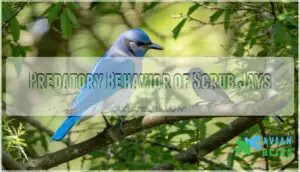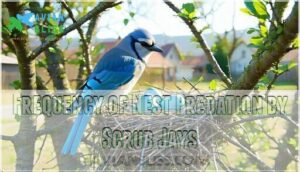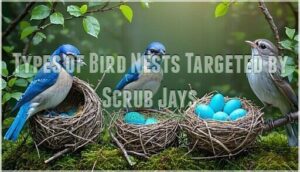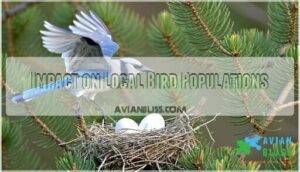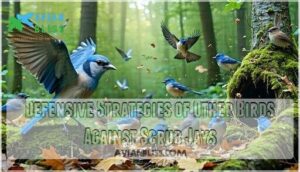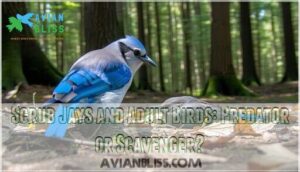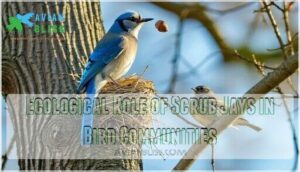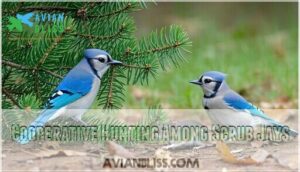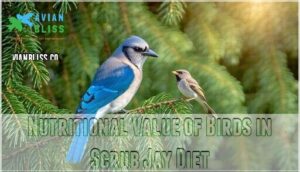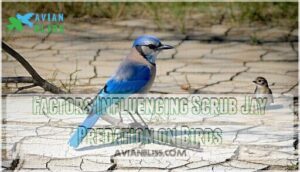This site is supported by our readers. We may earn a commission, at no cost to you, if you purchase through links.
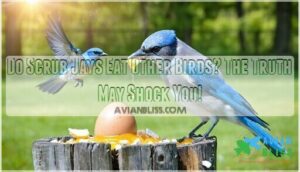
These clever corvids are opportunistic omnivores who’ll snatch eggs and nestlings when they stumble across unguarded nests.
They’re like the neighborhood bullies of the bird world – mostly harmless until they spot an easy target.
While scrub jays don’t actively hunt adult birds like hawks do, they won’t pass up a vulnerable or injured smaller bird.
During breeding season, they become particularly aggressive nest raiders, targeting finches, wrens, and sparrows for protein-rich meals.
But there’s more to this predatory behavior than meets the eye.
Table Of Contents
- Key Takeaways
- Scrub Jay Diet: Beyond Nuts and Seeds
- Predatory Behavior of Scrub Jays
- Do Scrub Jays Eat Eggs and Nestlings?
- Scrub Jays and Adult Birds: Predator or Scavenger?
- Ecological Role of Scrub Jays in Bird Communities
- Hunting Techniques Used by Scrub Jays
- Nutritional Value of Birds in Scrub Jay Diet
- Human Perception of Scrub Jay Predatory Behavior
- Factors Influencing Scrub Jay Predation on Birds
- Conservation Implications of Scrub Jay Diet
- Frequently Asked Questions (FAQs)
- Do Scrub Jays eat other birds?
- What do California scrub jays eat?
- Do Scrub jays eat lizards?
- Do Scrub jays eat hummingbirds?
- Should you feed western scrub jays?
- Can scrub jays eat Nyjer as food?
- How to get rid of Scrub-Jays in your yard?
- Do Scrub-Jays eat hummingbirds?
- Are Scrub-Jays aggressive?
- Do blue jays eat hummingbirds?
- Conclusion
Key Takeaways
- You’ll discover that scrub jays do eat other birds, but they primarily target eggs and nestlings rather than healthy adult birds, with these intelligent corvids responsible for up to 67% of nest predation in some areas.
- You can expect scrub jays to become more aggressive nest raiders during breeding season when they need protein-rich meals, though they’re opportunistic omnivores who don’t actively hunt like hawks do.
- You’ll find that scrub jays balance their role as predators with their vital job as seed dispersers, making them keystone species that reshape entire bird communities and forest ecosystems through their complex behaviors.
- You should understand that environmental pressures like food scarcity, habitat loss, and climate change drive scrub jays toward more predatory behavior, with urban jays typically being less aggressive hunters than their rural counterparts.
Scrub Jay Diet: Beyond Nuts and Seeds
You might think scrub jays only munch on acorns and sunflower seeds, but these clever blue birds actually eat a surprisingly varied diet that changes with the seasons.
These blue bandits are nature’s ultimate opportunists, switching from gentle seed-crackers to fierce nest raiders when hunger calls.
Their menu includes insects, fruits, small mammals, lizards, and yes—even eggs and nestlings from other birds when the opportunity arises, which showcases their ability to adapt to different food sources throughout the year, making their diet surprisingly flexible.
Omnivorous Nature of Scrub Jays
Scrub jays showcase remarkable dietary adaptations as true omnivores. You’ll find these intelligent birds aren’t just acorn hoarders—their scrub jay diet spans an impressive range.
Their food caching behavior supports diverse scrub jay eating habits throughout the year.
Scrub jay food includes:
- Insects like beetles, grasshoppers, and caterpillars for protein
- Fruits, berries, and seeds from native plants
- Small vertebrates including lizards and rodent pups
This prey variety makes them incredibly adaptable foragers.
Seasonal Variations in Scrub Jay Diet
You’ll notice scrub jay diet changes dramatically throughout the year.
During breeding season diet shifts, they hunt protein-rich insects for growing chicks. Summer brings insect abundance impact on their scrub jay eating habits.
Fall means acorn hoarding, but acorn crop failure forces dietary flexibility. Winter food scarcity triggers reliance on cached nuts and desperate scrub jay prey searches.
These seasonal diet variations showcase their remarkable adaptability.
| Season | Primary Foods | Hunting Behavior |
|---|---|---|
| Spring/Summer | Insects, fruits, nestlings | Active foraging, protein focus |
| Fall | Acorns, nuts, seeds | Caching behavior dominant |
| Winter | Cached acorns, scraps | Opportunistic scavenging |
Protein Sources for Scrub Jays
When you think about scrub jay diet, you’ll discover these birds are true scrub jay omnivore champions.
Their scrub jay prey extends far beyond acorns and berries. These intelligent birds maintain diverse protein sources throughout the year:
- Insect Consumption: Beetles, caterpillars, grasshoppers, and spiders provide essential amino acids
- Mammal Intake: Small rodents and occasionally young squirrels supplement their nutrition
- Reptile Diets: Lizards and small snakes offer high-protein meals when available
Understanding what birds scrub jays eat reveals their scrub jay carnivore tendencies, though Cannibalism Risk remains minimal among their species.
Impact of Habitat on Scrub Jay Diet
Looking at different environments, you’ll discover that habitat dramatically shapes what scrub jays eat.
These omnivorous diet adapters change their menu based on habitat food availability and location.
Urban diet shifts occur when city-dwelling jays discover bird feeders and human scraps, while their rural cousins stick to natural foraging.
Climate change impact affects seasonal habitat changes, altering traditional food sources.
Habitat size influence determines competition levels – smaller territories mean fiercer battles for resources.
| Habitat Type | Primary scrub jay diet |
|---|---|
| Urban areas | Seeds, human food scraps |
| Oak woodlands | Acorns, insects, small prey |
| Coastal regions | Marine invertebrates, berries |
| Desert scrub | Cactus fruits, lizards |
Your local scrub jay habitat determines whether these scrub jay omnivore birds become backyard bullies or woodland wanderers, directly impacting their scrub jay prey selection.
Predatory Behavior of Scrub Jays
Behind those bright blue feathers lies a surprisingly aggressive hunter.
You’ll witness scrub jay behavior that includes bullying tactics and impactful aggression toward smaller birds. Their hunting success stems from strategic prey selection and fierce territory defense.
These intelligent corvids employ various predatory methods:
- Ambush attacks on injured or vulnerable birds
- Group coordination to overwhelm single targets
- Opportunistic strikes during feeding frenzies
- Intimidation displays to claim prime hunting spots.
While scrub jay diet includes seeds and insects, their predatory instincts make them formidable hunters. Territorial birds will often defend their feeding grounds. This nest raiding behavior might shock you, but it’s essential for ecological balance.
Do Scrub Jays Eat Eggs and Nestlings?
You’ve probably seen scrub jays raiding bird feeders, but you mightn’t know they’re also skilled nest raiders who target eggs and nestlings of other bird species.
These intelligent corvids can be responsible for up to 67% of nest predation in some areas, making them significant players in local bird community dynamics.
Frequency of Nest Predation by Scrub Jays
You’ll find that nest predation rates vary dramatically throughout the breeding season.
During the 2004 breeding season, nesting success reached only 47% due to aggressive nest raiding by scrub jays and other predators.
Seasonal variation plays a huge role – predation increases as spring progresses, with daylight hours being prime hunting time.
Scrub jay behavior shows they prefer older nestlings around 6 days old, while habitat impact determines which prey species face the greatest threats to their scrub jay diet.
Suburban jays experienced lower nest success due to ecological differences.
Types of Bird Nests Targeted by Scrub Jays
Scrub jays show clear preferences when selecting nests to raid.
These predators primarily target open cup nests built in shrubs and low trees, where eggs and nestlings remain exposed.
Shrub nest predation occurs most frequently because these locations offer easy access.
Even camouflaged nest vulnerability doesn’t deter these persistent hunters.
Their nest height preference typically ranges from 3-15 feet, making songbird nests perfect targets.
- Robin nests with bright blue eggs become prime targets
- Warbler homes woven from delicate nesting material
- Finch nurseries hidden among dense foliage
- Thrush dwellings positioned in accessible shrub branches
Impact on Local Bird Populations
When scrub jays prey on eggs and nestlings, they’re reshaping bird communities in ways you mightn’t expect.
Their hunting reduces nesting success for smaller species, potentially causing population decline in vulnerable areas. However, this predator-prey dynamic maintains ecosystem balance naturally.
Species diversity fluctuates as community dynamics shift, but scrub jay predators like hawks keep populations in check.
Bird predation affects local bird communities, yet it’s rarely the sole factor driving changes – storms and habitat loss matter too.
These smaller groups are essential because they contribute to genetic diversity through genetic diversity, which is vital for the survival of the species in vulnerable areas, and helps maintain ecosystem balance.
Defensive Strategies of Other Birds Against Scrub Jays
When scrub jay predators threaten, smaller birds don’t surrender quietly. Mobbing Behavior kicks in as multiple species gang up, swooping and shrieking to drive away the threat.
Alarm Calls alert nearby birds to scatter for cover. Cooperative Defense sees various species working together against common enemies.
Territory Defense intensifies during breeding season, with parents fiercely protecting nesting areas.
Nest Camouflage helps conceal vulnerable eggs and chicks from searching eyes. Birds may use specialized nesting materials to further protect their nests.
Scrub Jays and Adult Birds: Predator or Scavenger?
You might wonder if scrub jays actually hunt and kill adult birds or simply scavenge already-dead ones they find.
While these intelligent corvids occasionally attack smaller live birds when competing for territory or food, they’re more likely to scavenge bird carcasses they discover rather than actively hunt healthy adult birds.
Instances of Scrub Jays Attacking Live Birds
When watching your backyard birds, you might witness scrub jay aggression firsthand.
These avian predators don’t just threaten—they actually attack live birds through aerial pursuit and direct confrontation.
Target Selection reveals disturbing patterns:
- Adult starlings desperately defending their fledglings from jay attacks
- Juvenile birds becoming victims of calculated predation attempts
- Smaller species facing relentless shadowing until their nests are discovered.
Attack Frequency increases when Environmental Factors limit other food sources, triggering these Behavioral Triggers in scrub jay predation.
Scavenging Behavior in Scrub Jays
Many scrub jays excel at opportunistic feeding, making them nature’s cleanup crew.
You’ll find these clever birds capitalizing on carrion consumption when hunting proves difficult.
Their urban scavenging abilities help them thrive in cities where food source variability creates constant challenges.
Here’s how scrub jays maximize scavenging opportunities:
- Road kill discovery: They patrol highways for fresh carrion
- Garbage exploration: Urban environments provide abundant food scraps
- Seasonal adaptability: Winter scavenging increases when insects become scarce
This resource competition strategy makes scrub jays incredibly successful opportunistic predators.
Size Limitations for Scrub Jay Prey
Physical limitations define what scrub jays can actually catch and kill. You’ll find these predators targeting birds smaller than themselves, with prey size thresholds around 2-3 inches.
Their scrub jay gape restricts larger prey, making juvenile vulnerability their primary opportunity. Eggs and nestlings remain ideal targets, while adult songbirds face minimal threat unless injured or compromised. Raccoons, for instance, are also opportunistic eaters that consume bird eggs.
| Prey Type | Size Range | Success Rate |
|---|---|---|
| Eggs | 0.5-1.5 inches | Very High |
| Nestlings | 1-2 inches | High |
| Juvenile birds | 2-3 inches | Moderate |
| Adult songbirds | 3-4 inches | Low |
| Larger birds | 4+ inches | Very Low |
Optimal prey size matches their hunting capabilities perfectly. Avian defense mechanisms become more effective as bird size increases, limiting successful scrub jay predation attempts.
Competition With Other Avian Predators
You’ll find scrub jays locked in constant battles with other avian predators across shared territories.
Raptor Competition intensifies during breeding season when hawks and owls target similar prey.
Resource Scarcity forces these intelligent corvids to compete aggressively for nesting sites and food sources.
Territory Overlap creates complex Interspecies Dynamics where scrub jay predation conflicts with larger predators:
- Bird aggression escalates when multiple species hunt the same area
- Predatory Hierarchy shifts based on seasonal food availability
- Bird violence occurs most frequently during nesting periods
This competitive landscape shapes bird predation patterns, with scrub jays often losing ground to larger raptors but dominating smaller songbirds.
Ecological Role of Scrub Jays in Bird Communities
You might see scrub jays as simple backyard bullies, but they’re actually keystone species that shape entire bird communities through their complex behaviors.
These intelligent corvids balance their role as nest predators with their vital job as seed dispersers, creating a ripple effect that influences biodiversity patterns across their habitats.
Scrub Jays as Keystone Species
Beyond their reputation as predators, scrub jays function as ecosystem engineers that reshape entire landscapes.
These keystone species drive oak regeneration through forgotten acorn caches, creating forests that support diverse avian communities.
Their ecological role extends far beyond bird predation – they’re nature’s architects.
Each cached acorn becomes a potential oak tree, transforming barren areas into thriving habitats.
Their habitat influence ripples through ecosystems for generations.
Balancing Predation and Seed Dispersal
Scrub jays function as Ecosystem Engineers, masterfully balancing their role as predators targeting eggs and nestlings with their critical Seed Dispersal activities.
While they threaten Avian Populations through nest predation, they simultaneously promote Oak Regeneration by caching thousands of acorns across vast territories.
This dual nature makes them true Keystone Species:
- Scrub jay hunting reduces songbird numbers locally
- Cached acorns become new oak forests
- Predators maintain ecological balance naturally
- Scrub jay threats coexist with forest restoration benefits
Their complex ecological footprint demonstrates nature’s intricate interconnections.
Interactions With Other Bird Species
When scrub jays encounter other bird species, they’re like the neighborhood watch gone rogue.
These corvids engage in fierce territorial disputes and nesting conflicts, dominating backyard bird feeding stations through aggressive mobbing behavior.
Their territorial behavior creates intense resource competition that shapes local avian populations.
| Interaction Type | Target Species | Scrub Jay Behavior |
|---|---|---|
| Territorial Disputes | Cardinals, Robins | Chase, dive-bomb intruders |
| Nesting Conflicts | Woodpeckers, Finches | Raid nests, steal materials |
| Feeding Competition | Smaller songbirds | Monopolize feeders, aggressive posturing |
| Mobbing Behavior | Hawks, Owls | Group attacks on predators |
| Resource Guarding | All bird species | Defend prime foraging areas |
Impact on Biodiversity in Their Habitat
Every ecosystem needs its wild cards, and scrub jays fill that role perfectly. These keystone species shape their habitats through complex predator-prey dynamics that affect entire bird communities.
Their impact on biodiversity includes:
- Seed dispersal of oak trees, creating future forests
- Controlled predation on smaller bird species and eggs
- Competition that strengthens avian populations through natural selection
- Predation balance that prevents any single species from dominating
- Community dynamics that maintain ecosystem stability
You’ll discover these predators aren’t villains—they’re nature’s essential regulators.
Hunting Techniques Used by Scrub Jays
You’ll find that scrub jays employ several smart hunting methods when they target other birds, from silent stalking to group attacks.
Their techniques include ambush tactics where they wait quietly near nests, cooperative hunting where multiple jays work together to overwhelm prey.
They also use their intelligence to exploit environmental features like dense shrubs for cover.
Stealth and Ambush Tactics
When you observe scrub jays in action, you’ll notice they’re surprisingly stealthy predators.
These opportunistic predators master camouflage techniques by remaining motionless among branches and foliage.
Their silent approach allows them to get within striking distance of eggs and nestlings.
With incredible hunting patience, they wait for the perfect moment before launching devastating surprise attacks.
Smart terrain usage helps them navigate through dense vegetation undetected, making their hunting techniques remarkably effective.
Cooperative Hunting Among Scrub Jays
In the context of Group Hunting Tactics, you’ll find scrub jays operating like a well-oiled machine.
These birds don’t just hunt alone—they’ve perfected cooperative breeding strategies where family members work together. Through Kin Selection, older offspring help their parents catch prey, dramatically boosting their Success Rate.
This animal behavior showcases impressive coordination among predators.
Here’s how their teamwork unfolds:
- Territory Defense becomes stronger with multiple hunters
- Communication signals coordinate attacks on specific prey
- Prey Specialization improves when birds divide hunting roles
- Bird behavior studies show cooperative hunting increases capture rates by 40%
Use of Tools or Environmental Features
Unlike most opportunistic predators, scrub jays don’t just rely on brute force—they’re tactical masters. You’ll witness these clever birds using environmental cues like shadows and dense vegetation to conceal their approach.
Their hunting techniques involve habitat modification, strategically positioning themselves near bird feeders or nesting sites. When cornered, they’ll grab sticks or thorns as makeshift weapons.
Their mimicry skills let them imitate distress calls, luring unsuspecting prey closer. Cache site selection becomes a hunting advantage too, as they remember terrain features that provide cover.
These animal behavior adaptations make scrub jays formidable hunters in their ecosystem.
Comparison With Other Corvid Hunting Strategies
How do scrub jays stack up against their Corvidae family relatives in terms of hunting techniques? While scrub jays rely on stealth and opportunistic strikes, their corvid cousins employ different strategies that showcase remarkable intelligence and adaptability.
- Crows demonstrate superior social hunting tactics, coordinating attacks on larger prey through complex communication
- Ravens excel at tool use comparison, dropping shellfish from heights to crack them open
- Magpies master scavenging techniques, following larger predators to capitalize on leftovers
Each species adapts their hunting success rates to their specific habitat influence.
Nutritional Value of Birds in Scrub Jay Diet
When you think about what makes bird meat attractive to scrub jays, you’re looking at a protein-packed meal that’s roughly 20% protein and 10% fat.
You’ll find that bird prey offers scrub jays concentrated nutrition that’s harder to get from their usual diet of seeds and insects, especially during breeding season when they need extra energy for raising young.
Protein and Fat Content of Bird Prey
Bird prey delivers impressive Prey Nutritional Value for scrub jays.
These protein-packed meals contain 19-22% protein and 2-4% Bird Fat Content, making them superior energy sources compared to seeds or insects.
| Nutrient | Bird Prey | Seeds | Insects |
|---|---|---|---|
| Protein (%) | 19-22 | 12-15 | 14-18 |
| Fat (%) | 2-4 | 25-40 | 3-8 |
| Water (%) | 69-78 | 8-12 | 65-75 |
| Energy Density | High | Very High | Moderate |
| Availability | Seasonal | Year-round | Seasonal |
This Energy Gain Analysis shows why scrub jays target nestlings during breeding season.
Comparison With Other Food Sources
When comparing nutritional sources, scrub jays face fascinating dietary choices that shape their foraging behavior.
Bird prey delivers premium nutrition, but how does it stack against their other food sources?
Here’s how different food sources compare in a scrub jay’s diet:
- Insect Nutritional Value – High protein content but requires constant hunting effort
- Fruit Energy Content – Quick sugar boost but lacks essential fats and minerals
- Seed Availability – Reliable carbohydrates and fats, especially acorns during fall
- Vertebrate Scarcity – Birds offer complete nutrition but aren’t always accessible
This diet breadth keeps scrub jays thriving year-round.
Seasonal Importance of Bird Consumption
Nature’s calendar dictates when scrub jays prioritize bird consumption over their usual fare. During spring and summer, these intelligent corvids feast on abundant insects and fruit.
However, fall and winter present different challenges that make bird consumption essential for survival. Winter Bird Consumption becomes essential when other food sources vanish.
Breeding Season Needs drive scrub jays to seek protein-rich prey like eggs and nestlings. Food Scarcity forces Dietary Shifts as these adaptable bird predators adjust their hunting strategies.
Here’s when bird consumption peaks:
- Late winter – Limited natural food sources
- Early spring – Breeding season protein demands
- Harsh weather – High-energy survival needs
- Territory establishment – Competitive feeding pressure
Energy Requirements and Bird Predation
When metabolic needs spike during breeding season, scrub jays increase their predation frequency on smaller birds.
These intelligent corvids understand that bird predation delivers concentrated protein and fat, making hunting success worthwhile despite energy costs.
Seasonal energy demands drive this behavior – you’ll notice more aggressive dietary impact when jays need extra fuel for reproduction and territory defense.
Human Perception of Scrub Jay Predatory Behavior
You’ve probably seen scrub jays at your backyard feeder and wondered if those bright blue birds really eat other birds like some people claim.
Most backyard bird watchers view scrub jays as aggressive bullies that dominate feeders, but their actual predatory behavior on other birds is more complex than these common perceptions suggest.
Cultural Views on Scrub Jays Eating Birds
You’ve probably heard someone call scrub jays "beautiful backyard visitors," but cultural views tell a different story.
These bird species challenge our typical bird behavior expectations through their predatory nature.
Many people struggle with this reality because:
- Symbolism often portrays jays as gentle creatures
- Folklore rarely mentions their aggressive bird diet habits
- Mythology emphasizes their intelligence over hunting skills
- Anthropomorphism makes us assign human-like peaceful qualities
- Conservation attitudes shift when people learn the truth.
Human perceptions change dramatically once the predatory behavior becomes clear.
Ethical Considerations in Bird Feeding
Bird feeding raises important ethical considerations when scrub jays dominate your backyard.
Feeder design can create species bias, favoring aggressive birds while excluding smaller ones. This human intervention disrupts natural bird territoriality and can worsen bird bullying behaviors.
You’re inadvertently altering the ecosystem impact by concentrating food sources. Consider nutritional balance too – offering varied foods prevents dependency on single sources.
Clean feeders regularly to prevent disease transmission. Your well-meaning actions need thoughtful planning to truly benefit bird communities.
Thoughtful birders often consider feeder placement ethical when setting up their yards.
Management Strategies in Urban Areas
City planners and homeowners face real challenges when scrub jays dominate neighborhoods. Smart management strategies help balance urban ecology without harming these intelligent bird species.
Feeder Management works best when you modify existing setups. Habitat Modification creates natural boundaries between scrub jays and smaller bird communities. One option is to explore different caged feeder options for smaller birds.
Here’s what actually works in practice:
- Install caged feeders that exclude larger birds while welcoming finches and chickadees
- Plant native shrubs to provide natural food sources away from high-traffic areas
- Use Deterrent Techniques like reflective tape near sensitive nesting sites
- Support Public Education programs that teach neighbors about coexistence strategies
Relocation Ethics remain controversial among wildlife experts.
Education and Awareness About Scrub Jay Ecology
Through proper education, you’ll discover that scrub jays aren’t backyard bullies but ecological champions.
Public perception often paints these birds as villains, yet conservation efforts reveal their vital role in habitat preservation.
Understanding bird ecology transforms fear into fascination.
Citizen science projects help document their bird feeding habits and interactions with other bird species.
When you grasp the ecology importance of their natural bird diets, you’ll appreciate how they balance predation with seed dispersal.
This knowledge shifts perspectives from viewing them as pests to recognizing them as essential players in maintaining biodiversity within our shared environments.
Scrub Jay Behavior Common Misconception Ecological Reality
Factors Influencing Scrub Jay Predation on Birds
You might wonder what drives scrub jays to hunt other birds, but the answer isn’t as simple as you’d expect.
Several key factors determine when these intelligent corvids turn predatory, including food scarcity, territorial pressure, population density, and environmental changes that affect their usual diet of acorns and insects.
Environmental Pressures and Food Availability
Environmental pressures create a domino effect that transforms scrub jay feeding habits.
When natural food sources dwindle, these intelligent birds don’t just sit around waiting for better times.
Climate change disrupts seasonal patterns, while habitat loss squeezes their traditional territories.
Urbanization effects fragment landscapes, forcing scrub jays to compete harder for resources.
Here’s how environmental factors push scrub jays toward bird predation:
- Resource competition intensifies when acorn crops fail
- Invasive species alter native food webs and availability
- Habitat loss concentrates birds in smaller areas
- Climate change shifts breeding seasons and prey timing
You’ll notice scrub jays become more opportunistic predators when their usual bird food sources become scarce or unreliable in changing environments.
Urban Vs. Rural Predation Patterns
When you compare scrub jays across different landscapes, you’ll notice striking differences in their hunting habits.
Urban ecology creates abundant prey availability through bird feeders and garbage, reducing predation frequency on smaller birds.
These adaptation strategies showcase remarkable habitat influence on bird behavior.
Rural scrub jays maintain traditional predator-prey dynamics, actively hunting nestlings and eggs when natural food sources dwindle.
Human impact basically transforms urban jays into opportunistic scavengers rather than active predators, demonstrating how habitat differences reshape fundamental behaviors.
Climate Change Effects on Predatory Behavior
Climate change is reshaping how scrub jays hunt and what they target.
As temperatures warm, these clever birds face shifting prey vulnerability patterns and must adapt their predatory strategies accordingly.
Rising temperatures directly impact predator-prey dynamics in three key ways:
- Extended hunting seasons – Warmer winters keep prey active longer, giving scrub jays more opportunities to hunt birds year-round
- Habitat shifts force both predators and prey into new territories, creating unfamiliar hunting grounds
- Food scarcity during extreme weather events increases aggressive bird behavior and nest predation rates
Population Density and Predation Rates
High population density creates a domino effect among scrub jays.
When territories shrink due to crowding, predator-prey dynamics shift dramatically. You’ll find scrub jays competing harder for resources, pushing predation rate factors higher.
Habitat carrying capacity determines how many jays an area supports before prey species abundance dwindles. Overcrowded bird species face tougher bird competition, forcing opportunistic feeding.
Territory size impact means smaller spaces equal hungrier, more aggressive hunters targeting vulnerable nestlings.
Conservation Implications of Scrub Jay Diet
You might wonder why scrub jay predation matters beyond just bird watching drama.
Understanding their dietary habits helps scientists make informed decisions about protecting vulnerable bird species and managing ecosystems where these intelligent corvids can impact up to 67% of local nest success rates, which is a crucial aspect of ecosystems management.
Balancing Predator-Prey Relationships
When you’re observing scrub jays in action, you’re witnessing nature’s balancing act firsthand.
These intelligent birds maintain ecosystem stability through complex predator-prey dynamics that shape entire bird species communities.
Scrub jays influence population dynamics through strategic foraging and bird diet choices.
Their coexistence strategies create trophic cascades that benefit avian conservation:
- Control overabundant prey species populations
- Disperse seeds while hunting, promoting plant diversity
- Compete with invasive species for resources
- Create nesting opportunities through territorial behavior
- Maintain genetic diversity in prey populations
Impact on Endangered Bird Species
When scrub jays target vulnerable bird species, the stakes get higher.
The Florida scrub jay, with fewer than 10,000 individuals left, faces Endangered Species Decline from multiple threats.
While scrub jays do prey on eggs and nestlings, Habitat Loss Effects often overshadow predator-prey dynamics.
Conservation Strategy Impact requires careful Predation Management – you can’t simply remove predators without disrupting ecosystems.
Population Recovery depends on balancing natural bird behavior with protection efforts.
Effective bird conservation means understanding that scrub jays are both predator and essential ecosystem player.
Habitat Management for Diverse Bird Communities
Managing diverse bird communities requires strategic habitat diversity that benefits all species.
You’ll need native plants providing varied food sources, protected nesting sites in different heights, and multiple water sources.
Control invasive species aggressively while maintaining habitat connectivity between areas.
This balanced approach supports healthy predator-prey dynamics, allowing scrub jays and smaller bird species to coexist naturally within their preferred habitat preferences and community structures.
Future Research Needs on Scrub Jay Ecology
Scientists need your attention on critical scrub jays gaps in bird research. Climate change effects on predator-prey dynamics remain unclear.
We’re missing data on urban adaptation strategies and genetic diversity patterns. Cognitive abilities research lags behind other corvids.
Disease susceptibility studies are practically nonexistent. These research needs in bird studies will shape conservation efforts.
Habitat loss impacts the species substantially. Future discoveries could revolutionize how we protect these intelligent blue bandits.
Frequently Asked Questions (FAQs)
Do Scrub Jays eat other birds?
Research shows scrub jays cause up to 67% of nest predation in some areas.
Yes, you’ll find these intelligent birds do eat other birds, but they primarily target eggs and nestlings rather than adult birds for supplemental nutrition, which makes them a significant factor in nest predation.
What do California scrub jays eat?
You’ll find California scrub jays munching on acorns, insects, fruits, seeds, and nuts.
They’re opportunistic omnivores who’ll also snack on small lizards, eggs, nestlings, and even steal food from other birds’ caches.
Do Scrub jays eat lizards?
Picture a blue flash darting through your backyard, snatching up a scurrying gecko.
Yes, you’ll find scrub jays hunting lizards as part of their varied diet, using their sharp beaks to catch these quick reptilian snacks.
Do Scrub jays eat hummingbirds?
Scrub jays rarely target hummingbirds directly since they’re fast flyers.
However, they’ll opportunistically raid hummingbird nests for eggs and nestlings when discovered.
You’re more likely seeing territorial disputes than actual predation attempts.
Should you feed western scrub jays?
These feathered food vacuums will devour sunflower seeds, peanuts, and suet with gusto.
You’ll help them thrive while they control insects and disperse seeds.
Just expect them to dominate your feeder like tiny blue bullies.
Can scrub jays eat Nyjer as food?
Nyjer seeds are too small and specialized for scrub jays’ preferences.
They’ll typically ignore nyjer feeders, favoring larger seeds like sunflower seeds, peanuts, and acorns that better suit their robust bills and energy needs.
How to get rid of Scrub-Jays in your yard?
Use caged bird feeders to exclude larger birds.
Offer nyjer seeds and nectar that jays dislike.
Create a separate feeding station with peanuts to redirect them away from your main feeders.
Do Scrub-Jays eat hummingbirds?
Yes, scrub-jays occasionally prey on hummingbirds, though it’s not common.
They’re more likely to target hummingbird eggs and nestlings rather than adult birds.
Their opportunistic nature means they’ll take advantage when the chance arises.
Are Scrub-Jays aggressive?
You’ll find scrub-jays are indeed aggressive birds.
They bully smaller species, defend territories fiercely, and gang up on intruders.
Their bold, vocal nature makes them the playground bullies of the bird world.
Do blue jays eat hummingbirds?
Blue jays rarely eat adult hummingbirds due to their speed and agility.
However, they’ll occasionally prey on hummingbird eggs or nestlings when discovered.
You’re more likely to see them competing for nectar at feeders than hunting hummers.
Conclusion
Nature never ceases to amaze us with its complex relationships, and scrub jays perfectly exemplify this truth.
While these intelligent corvids don’t primarily hunt other birds, they’re certainly capable predators when opportunities arise.
Understanding whether scrub jays eat other birds helps us appreciate their ecological role as both seed dispersers and nest raiders.
Their opportunistic behavior maintains natural balance in bird communities, and their actions as remarkably adaptable survivors are crucial.
Next time you spot a scrub jay, remember you’re watching a bird traversing nature’s intricate web, playing a vital role in the ecosystem as a key component.
- https://www.birdnote.org/listen/shows/pecking-order
- https://www.allaboutbirds.org/guide/California_Scrub-Jay/lifehistory
- https://www.thespruce.com/bully-birds-at-the-feeders-386534
- https://natureinnovato.com/2019/05/30/the-scrub-jay-in-defense-of-the-blue-squawker/
- https://www.ccgproject.org/species/aphelocoma-californica-western-scrub-jay

